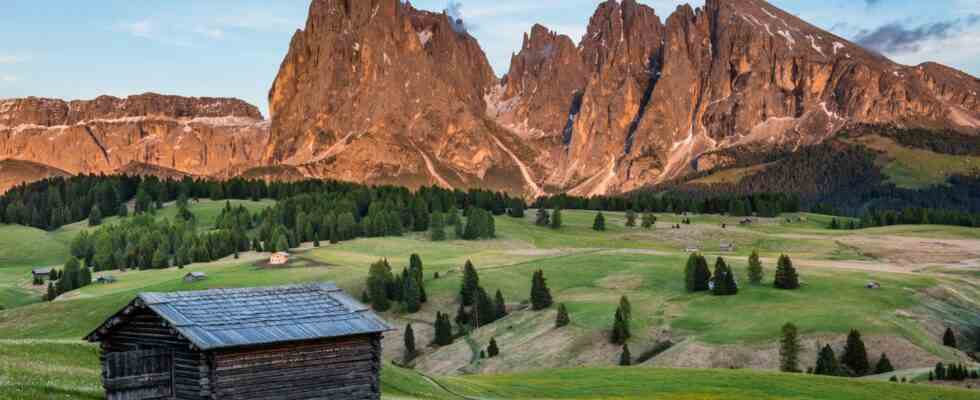There are also symbiotic relationships between regions, quite classic: valley and mountain. The same applies to the green Alm and the gray Sciliar ridge. One doesn’t work without the other. Only together does that picturesque picture emerge that has enchanted visitors for many generations. Its hilly topography makes the Alpe di Siusi the ideal hiking area: lots of views with little effort.
The hiker always has the Sassolungo massif or (if he turns around) the Schlern, two unmistakable rock profiles, in view. Weather-beaten wooden barns (Schwaigen) stand in the meadow, cow bells tinkle, and there is no shortage of places to stop for refreshments.
“The glacier’s silver tip, the forest’s damp green / The lake’s blue mirror, the alpine roses blooming / The waterfall’s roaring has many a mountain country / But an Alpe di Siusi – only the state of Tyrol has it.” Raoul Heinrich Francé quotes this somewhat bumpy ode to Alpine beauty in his book “The Alps”, published in 1912, and describes the Seiser Alm – quite rightly – as the “largest alp in the entire Alps and at the same time a paradise for alpine plants, which at the beginning of the XIX century prompted a veritable race of plant connoisseurs to the Sciliar and the Alpe di Siusi”. So many compliments didn’t go unnoticed.
At first, botanists in particular paid their respects to the Alm, but from the 1960s more and more tourists came. It was built and fertilized, dirt roads turned into roads, lifts made the mountain experience more convenient. In order to save at least part of the high pasture, the state government created the first regional nature park in 1974, against the strong resistance of farmers, hunters and hoteliers.
So the Schlern has not degenerated into a cable car mountain, but has remained a beautiful, traditional destination with the time-honoured Schlern houses just below the summit (Petz, 2563 m). It takes about three and a half hours from the Alpe di Siusi; the ascents from Völs via the Prügelsteig and from Weißlahnbad via the Bärenfalle are even longer, but also more exciting. A hot tip: spend the night up on the mountain and experience the twilight hours.
excerpt from the Illustrated book: “South Tyrol – Travel to the kingdom of the Dolomites” by David Koestler Nina Ruland and Eugene E. Hüsler, published by Frederking & Thaler.
Also read:
– South Tyrol: These are the 20 best wellness hotels
– Climbing in the Dolomites: 500 meters of air under your feet
– Rugged rocks and pale moonlight: on a nocturnal hiking tour in the Dolomites
This article contains so-called affiliate links. There is more information here.

